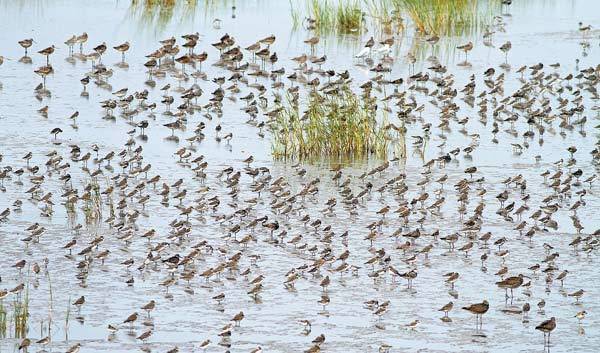Rare bird finds sanctuary
Updated: 2013-11-14 00:31
By Chen Liang (China Daily)
|
|||||||||||
|
 |
|
Intertidal mudflats in Rudong, Jiangsu province are one of the most important sites for migratory shorebirds on the East Asian-Australian Flyway. Dong Wenxiao / For China Daily |
There are fewer than 100 breeding pairs of the spoon-billed sandpiper left in the world, and a stretch of intertidal mudflats in Jiangsu province is one of the last resting places on their migration route. Chen Liang reports.
Few Chinese know of the spoon-billed sandpiper, a migratory wader about the size of a sparrow known for its flattened bill that flares into a "spoon" at the tip.
But the bird is a species found in China and it is much more endangered than the giant panda. In fact, it was listed as one of the 100 most endangered species on the planet by the International Union for Conservation and Zoological Society of London in 2012, with fewer than 100 breeding pairs left in the wild.
And China boasts of one of the best sites in the world to see this critically endangered bird in the wild — Xiao Yangkou in Rudong, Jiangsu province.
A small port north of the Yangtze River estuary and facing the southernmost part of the Yellow Sea, the site is known for its rich intertidal mudflats stretching for some 250 kilometers.
A recent survey by the conservation network SBS in China, supported by 15 water bird experts from the international SBS Task Force, an international conservation partnership for the bird's conservation, confirms the international importance of Rudong intertidal wetlands.
The survey was conducted from Oct 15 to 19 along the 120 km coastline near Rudong, by three members of SBS in China, a volunteer conservation group, and 15 ornithologists and conservationists from eight countries including the United States, Russia, United Kingdom, South Korea and Myanmar.
Every day they separate into two or four groups and travel in minivans, trying to locate every flock of migratory shorebirds that are stopping over while migrating from their breeding ground, mainly in Siberia, to their wintering ground in South and Southeast Asia.
Related Stories
Guardian embraces lake and its birds 2013-10-17 07:13
32 endangered birds released into the wild 2013-07-04 07:55
Floating nests help water birds thrive 2013-07-02 14:33
Birds live in harmony with nature in Bayanblak Wetlands, Xinjiang 2013-06-07 15:10
Today's Top News
Chinese opera looks to the West
Palace Museum looking to expand and preserve
Baidu sued amid claims of video copyright violation
Sustainable and quality growth 'to be achieved'
Banks' nonperforming loans up slightly in Q3
Investment treaty offers rewards
Middle class growing up for consumption
Communique encouraging: US expert
Hot Topics
Lunar probe , China growth forecasts, Emission rules get tougher, China seen through 'colored lens', International board,
Editor's Picks

|

|

|

|

|

|





